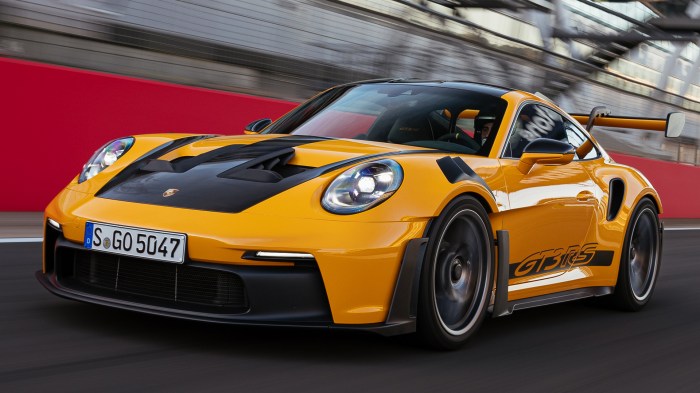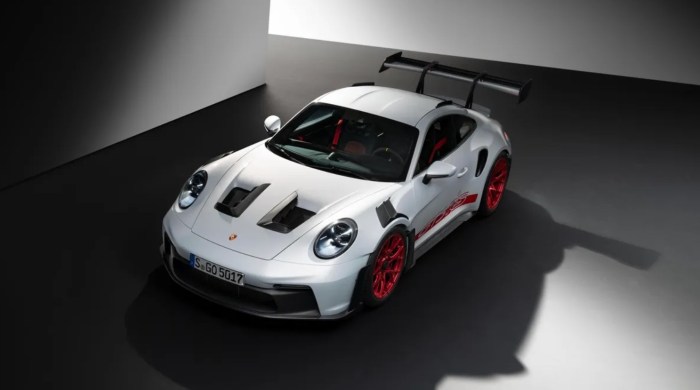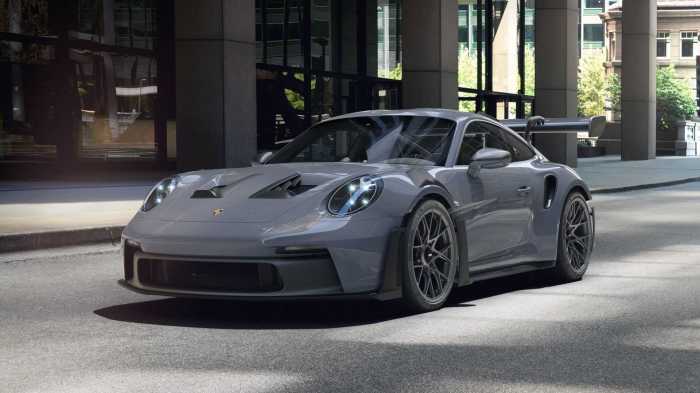How to upgrade a Porsche 911 GT3 RS? Dude, that’s a serious question! This isn’t your average Honda Civic; we’re talking about a legendary machine, a track-bred beast begging to be unleashed. We’ll dive deep into everything from squeezing extra ponies out of the engine to fine-tuning the suspension for ultimate handling. Get ready to transform your GT3 RS from awesome to absolutely insane.
This guide will walk you through the process of upgrading your Porsche 911 GT3 RS, covering performance enhancements, handling improvements, aerodynamic modifications, braking system upgrades, interior customizations, wheel and tire choices, and, of course, the all-important budget considerations. We’ll explore reputable modification companies, compare different upgrade options, and provide practical advice to help you make informed decisions. Think of this as your ultimate playbook for maximizing the performance and enjoyment of your already incredible machine.
Understanding the Porsche 911 GT3 RS

The Porsche 911 GT3 RS is not just a car; it’s a statement. It represents the pinnacle of Porsche’s road-going performance, a machine meticulously engineered for track dominance while remaining (relatively) street legal. Understanding its capabilities requires delving into its factory specifications, performance features, and comparing it to its less extreme siblings within the 911 family. This exploration will illuminate what makes the GT3 RS truly special.Factory Specifications of the Porsche 911 GT3 RS (992 Generation)The 992 generation Porsche 911 GT3 RS, released in 2022, boasts impressive specifications.
At its heart lies a naturally aspirated 4.0-liter flat-six engine, producing a thunderous 518 horsepower and 343 lb-ft of torque. This power is channeled through a seven-speed PDK dual-clutch transmission, enabling lightning-fast shifts. The car’s lightweight construction, utilizing extensive carbon fiber components, contributes significantly to its exceptional performance. Aerodynamics play a crucial role, with an aggressive rear wing and various aerodynamic aids generating significant downforce, enhancing high-speed stability and cornering grip.
Its suspension is tuned for track-focused handling, providing exceptional responsiveness and control.Key Performance Features of the Base ModelThe base model GT3 RS excels in several key areas. Its acceleration is breathtaking, capable of launching from 0 to 60 mph in under 3 seconds. Top speed is electronically limited, but the car easily surpasses 190 mph. The handling is precise and responsive, allowing for incredibly quick lap times on a race track.
The braking system is equally impressive, featuring massive carbon-ceramic brakes capable of bringing the car to a standstill from high speeds with remarkable control. The combination of power, handling, and braking makes the GT3 RS a formidable track weapon.Comparison to Other Porsche 911 ModelsThe GT3 RS distinguishes itself significantly from other 911 models. Compared to the standard 911 Carrera or even the 911 GT3, the RS is far more track-focused.
It features a more aggressive aerodynamic package, a more extensively tuned suspension, and a lighter overall weight. While the GT3 offers excellent performance, the RS prioritizes track performance over everyday usability. Features like rear-wheel steering and active aerodynamics further enhance its handling capabilities, pushing the limits of what’s possible on a racetrack. The differences are not merely incremental; they represent a significant leap in performance and handling capabilities, making the RS a true outlier in the 911 lineup.
For example, the lap times achieved by a GT3 RS on the Nürburgring Nordschleife are considerably faster than those of a standard 911 Carrera or even the 911 GT3, showcasing the extent of its performance advantage.
Performance Upgrades

So, you’ve got a GT3 RS, huh? Impressive. But let’s be honest, even Porsche’s masterpiece can benefit from a little extra oomph. This section dives into the world of engine and drivetrain modifications, outlining potential upgrades and their impact on your already exhilarating driving experience. We’ll cover everything from horsepower boosts to enhanced handling, keeping it practical and avoiding any overly theoretical discussions.
Engine Upgrades for Increased Horsepower and Torque
Upgrading the GT3 RS’s engine isn’t just about adding horsepower; it’s about refining the already incredible power delivery and enhancing the overall driving experience. Several reputable companies offer a range of modifications, from simple ECU remaps to extensive internal engine work. Choosing the right upgrade depends on your budget and desired performance gains. It’s important to remember that any significant engine modification should be done by experienced professionals to ensure reliability and safety.
| Upgrade Option | Company | Estimated Cost (USD) | Estimated Horsepower Gain |
|---|---|---|---|
| ECU Remap | TechArt, M&M Automotive | $2,000 – $5,000 | 30-50 hp |
| Exhaust System Upgrade (Headers, Cat-Back) | Akrapovič, IPE Exhaust | $5,000 – $15,000 | 20-40 hp |
| Forced Induction (Turbocharger or Supercharger) | Several custom shops, (Specific company examples require extensive research and are highly dependent on the specific engine configuration) | $20,000+ | 100+ hp |
| Engine Internal Upgrades (Camshafts, Connecting Rods, Pistons) | (Highly specialized shops; requires significant engine disassembly and rebuilding; specific company examples require extensive research and are highly dependent on the specific engine configuration) | $30,000+ | 80+ hp |
Note: The cost and horsepower gains are estimates and can vary significantly depending on the specific components used and the installer’s expertise. Always consult with a reputable tuner for accurate estimations.
Drivetrain Modifications: Clutches and Differentials
While engine upgrades boost power, drivetrain modifications ensure that power is effectively transferred to the wheels. Upgraded clutches are crucial for handling the increased torque from engine modifications, preventing slippage and ensuring consistent power delivery. Similarly, upgraded differentials can improve traction and handling, particularly during aggressive driving maneuvers. For instance, a limited-slip differential (LSD) will significantly improve cornering grip and reduce wheelspin.
These modifications are essential for maximizing the benefits of any engine upgrade. Choosing the right clutch and differential depends on the level of engine modification and driving style. A more aggressive driving style would benefit from a more robust clutch and a more performance-oriented differential.
Hypothetical Engine Upgrade Plan: Stage 1
This plan focuses on a moderate upgrade, balancing performance gains with cost and maintainability. Components:
- ECU Remap from a reputable tuner like TechArt.
- Akrapovič Evolution Line exhaust system.
- Upgraded air intake system (potentially a cold air intake).
Installation Process:The ECU remap is typically performed via a diagnostic port, requiring minimal disassembly. The exhaust system installation involves replacing the factory exhaust components, requiring some mechanical expertise. The air intake system installation varies depending on the chosen system but usually involves replacing the factory air box and associated components. All installations should be performed by a qualified mechanic specializing in Porsche vehicles.
Proper tuning and break-in procedures are critical after installation.
Handling & Suspension Upgrades: How To Upgrade A Porsche 911 GT3 RS
Upgrading the suspension on your Porsche 911 GT3 RS is a crucial step for anyone looking to maximize its already impressive handling capabilities, whether you’re focused on track days or simply enhancing the driving experience on the street. The factory suspension is fantastic, but there’s always room for improvement and tailoring the setup to your specific driving style and preferences.
This section will explore common upgrades and their effects.The goal of any suspension upgrade is to improve grip, responsiveness, and control, ultimately leading to faster lap times on the track and a more engaging driving experience on the road. This is achieved by modifying various components to fine-tune the car’s balance, reduce body roll, and improve tire contact.
Coilover Kits
Coilover kits replace the factory shocks and springs with a fully adjustable system. This allows for precise control over ride height, spring rate, and damping. Higher spring rates generally improve handling by reducing body roll, but can make the ride harsher. Conversely, adjustable damping allows you to fine-tune the suspension’s response to different road conditions and driving styles.
For example, a stiffer setup with increased damping would be ideal for track use, while a softer setup with reduced damping might be preferred for daily driving. Many reputable manufacturers offer coilover kits specifically designed for the GT3 RS, offering various spring rates and damping adjustments to suit different preferences. Choosing the right kit depends on your driving style and intended use.
A track-focused setup will prioritize handling and responsiveness, while a street-focused setup will balance performance with comfort.
Sway Bars
Sway bars, also known as anti-roll bars, connect the left and right suspension components, reducing body roll during cornering. Thicker sway bars increase stiffness, further reducing body roll and improving handling. However, excessively stiff sway bars can negatively impact ride quality and traction, especially on uneven surfaces. Upgrading to thicker sway bars is a relatively simple and cost-effective modification that can significantly improve handling, particularly in high-speed cornering.
Many aftermarket manufacturers offer sway bars with varying thicknesses to fine-tune the balance of the car’s handling characteristics. Again, the optimal thickness depends on your driving style and the intended use of the vehicle.
Other Relevant Suspension Components
Beyond coilovers and sway bars, other components can be upgraded to further refine the handling. These include:
- Bushings: Replacing factory rubber bushings with stiffer polyurethane or other performance bushings reduces flex in the suspension, improving responsiveness and precision.
- Control Arms: Upgrading to adjustable control arms allows for fine-tuning of camber and caster, optimizing tire contact patch and handling.
- Strut Mounts: Upgrading to performance strut mounts reduces flex and improves steering feel.
These upgrades are often less impactful individually than coilovers and sway bars but can contribute to a more complete and refined handling package when combined.
So you’re looking to upgrade your Porsche 911 GT3 RS? That’s awesome! Thinking about performance parts? Don’t forget about the financial side; if you use it for business, check out Luxury car tax deductions for business use to see how you might offset those costs. Then, you can get back to focusing on those sweet new carbon fiber upgrades!
Reputable Suspension Tuning Companies
Several companies specialize in Porsche suspension tuning, each with its own strengths and areas of expertise. Choosing the right company depends on your budget and desired level of customization.
So you wanna upgrade your Porsche 911 GT3 RS? Think beyond the carbon fiber bits; consider the in-car experience. Check out how AI-driven personal assistants in luxury cars are changing the game, offering personalized settings and seamless connectivity. Then, armed with that knowledge, you can decide if a new infotainment system is the perfect next upgrade for your beast of a machine.
- KW Automotive: Known for their high-quality coilover kits and extensive adjustability.
- Bilstein: A long-standing name in the performance suspension industry, offering a wide range of shocks and struts.
- Öhlins: Renowned for their high-performance dampers, often used in motorsport applications.
- MCS Suspension: Specializes in custom suspension setups tailored to individual driver preferences and driving styles.
These companies represent a fraction of the many excellent options available; research and comparison are key to finding the perfect setup for your needs.
Aerodynamics & Exterior Modifications
Upgrading your Porsche 911 GT3 RS’s aerodynamics isn’t just about looking fast; it’s about actuallybeing* faster and more controlled. Aerodynamic modifications significantly impact downforce, stability, and overall handling, allowing for higher cornering speeds and improved braking performance. Let’s dive into how these changes can transform your driving experience.Aerodynamic modifications, primarily through spoilers and diffusers, manipulate airflow around the car to generate downforce.
Downforce pushes the car onto the track, increasing grip and traction, especially at high speeds. Spoilers create downforce by deflecting air upwards, while diffusers accelerate airflow underneath the car, creating a low-pressure area that sucks the car down. The balance between front and rear downforce is crucial for handling; too much rear downforce can lead to oversteer, while too much front downforce can cause understeer.
Rear Wing Options and Performance Impact
Different rear wing designs offer varying levels of downforce. A stock GT3 RS wing provides a good balance, but aftermarket options range from subtle upgrades offering a modest increase in downforce to massive wings generating significantly more downforce, often at the expense of increased drag. For example, a larger, adjustable wing allows the driver to tailor downforce to specific track conditions.
A smaller, more subtle wing might be preferred for street driving where maximizing downforce isn’t as crucial. Choosing the right wing depends on your intended use and driving style. A wing with a higher angle of attack will produce more downforce but also more drag, affecting top speed.
Installing a Larger Rear Wing
Installing a larger rear wing requires careful planning and execution. You’ll need a set of metric sockets and wrenches, a torque wrench (to avoid over-tightening and damaging the wing or bodywork), and potentially a lift or jack stands for easier access. Safety precautions are paramount: Always disconnect the battery before starting any electrical work. Work in a well-ventilated area, and wear safety glasses to protect your eyes from flying debris.
Consult the specific installation instructions provided with the aftermarket wing; these instructions will vary depending on the manufacturer and model. Properly torquing the fasteners is critical to ensure the wing is securely mounted and doesn’t come loose at high speeds.
Visual Description of a Modified GT3 RS
Imagine a GT3 RS, its already aggressive stance further amplified. A massive, adjustable rear wing dominates the rear, its carbon fiber weave gleaming in the sunlight. A front splitter extends low to the ground, creating a more pronounced lip and directing airflow smoothly under the car. Side skirts, also in carbon fiber, hug the body, reducing turbulence and improving airflow.
A diffuser at the rear, carefully integrated into the bumper, further enhances downforce. The overall effect is one of purposeful aggression, a machine sculpted for speed and precision. The increased downforce generated by these modifications is visually apparent in the car’s stance; it sits lower and more planted, ready to devour corners. The changes aren’t just aesthetic; they are functional upgrades designed to maximize performance on the track.
The carbon fiber components not only enhance the visual appeal but also reduce weight, further improving performance.
Braking System Enhancements

The Porsche 911 GT3 RS, even in stock form, boasts incredible braking performance. However, pushing the car to its limits on the track, or simply wanting an even more responsive and fade-resistant braking system, often leads enthusiasts to explore upgrades. These enhancements aren’t just about stopping faster; they’re about maintaining consistent stopping power under extreme stress, ensuring safety and maximizing track performance.Upgrading the braking system involves careful consideration of several components working in concert.
A holistic approach, rather than simply swapping out one part, yields the best results. Choosing the right components and understanding their interplay is crucial for a significant improvement.
Upgraded Brake Components
Selecting higher-performance brake pads, rotors, and calipers significantly improves braking capability. For example, high-performance brake pads made from materials like carbon-ceramic or racing compounds offer increased friction coefficient, resulting in shorter stopping distances and better modulation. Larger diameter rotors, often with improved ventilation and heat dissipation designs (like two-piece or floating rotors), help manage heat build-up under heavy braking.
Upgraded calipers, typically made from lightweight materials like aluminum or forged materials, offer increased clamping force and improved heat transfer. Specific examples include Brembo GT or AP Racing calipers, which are popular choices for GT3 RS upgrades. These calipers often incorporate larger pistons for enhanced stopping power. A common upgrade path might involve replacing the stock steel rotors with larger diameter two-piece rotors and installing race-compound pads designed for high-temperature performance in conjunction with upgraded calipers.
Brake Fluid Selection
Brake fluid’s boiling point is a critical factor in high-performance braking. High-temperature brake fluids are essential to prevent vapor lock, a condition where the brake fluid boils under extreme heat, resulting in a spongy brake pedal and reduced braking effectiveness. Standard DOT 3 or DOT 4 fluids have relatively low boiling points, making them unsuitable for track use or aggressive driving.
DOT 5.1 fluids offer a significantly higher boiling point, providing better fade resistance. Some high-end racing fluids, such as Motul RBF660, boast even higher boiling points, further enhancing performance under extreme conditions. The choice of brake fluid should be carefully considered based on the intended use and the overall braking system upgrade plan.
Braking System Upgrade Plan, How to upgrade a Porsche 911 GT3 RS
A comprehensive braking system upgrade for a GT3 RS might include the following stages:
- Stage 1: Brake Fluid Upgrade: Replacing the stock brake fluid with a high-performance DOT 5.1 fluid like Motul RBF660 is a relatively inexpensive and effective first step. This immediately improves high-temperature performance and fade resistance.
- Stage 2: Brake Pad Upgrade: Upgrading to high-performance brake pads designed for track use. This will noticeably improve stopping power and feel. The choice of pad compound will depend on the track conditions and driving style.
- Stage 3: Rotor Upgrade: Installing larger diameter, two-piece or floating rotors significantly improves heat dissipation and reduces the risk of rotor warping under extreme braking.
- Stage 4: Calipers Upgrade: Upgrading to larger, higher-performance calipers (e.g., Brembo GT or AP Racing) offers the most significant increase in stopping power. This stage requires professional installation and is typically the most expensive.
This staged approach allows for incremental improvements, enabling fine-tuning and optimization based on driver feedback and experience. Each stage builds upon the previous one, leading to a progressively more effective and resilient braking system.
Interior & Comfort Upgrades
Upgrading your GT3 RS’s interior isn’t just about aesthetics; it’s about balancing performance and driver comfort. This involves careful consideration of weight reduction strategies versus maintaining a comfortable and enjoyable driving experience. Choices range from hardcore racing modifications to subtle refinements.The trade-off between weight reduction and comfort is a central theme in GT3 RS interior modifications. Removing components saves weight, improving handling and acceleration, but it can significantly impact the everyday usability and comfort of the car.
Think about the difference between a stripped-down race car and a comfortable daily driver – that’s the spectrum you’re navigating.
Lightweight Seating Options
Replacing the standard seats with lightweight racing seats is a popular upgrade. These seats, often made from carbon fiber or fiberglass reinforced plastic (FRP), significantly reduce weight compared to the stock seats. For example, a set of Recaro Pole Position seats can shave off a considerable amount of weight, but they’re less comfortable for longer drives and lack some of the adjustability of the stock seats.
This trade-off is crucial to consider; the increased performance from reduced weight must be weighed against the potential discomfort.
Interior Trim Upgrades
Upgrading interior trim offers a less extreme approach to improving the cabin. Replacing standard trim pieces with carbon fiber or Alcantara alternatives can enhance the aesthetic appeal and subtly reduce weight. Alcantara, for example, is a microfiber suede material that offers a luxurious feel while being lighter than leather. This approach allows for a balance between performance enhancement and a refined driving experience.
The weight savings are less dramatic than with seat replacements, but the overall effect can still be noticeable.
Infotainment System Enhancements
While not directly impacting weight, upgrading the infotainment system can significantly enhance the driving experience. Modern aftermarket systems offer improved navigation, audio quality, and connectivity features. The improved user interface can lead to a more enjoyable driving experience, although this is purely a comfort-focused upgrade with minimal or no impact on performance.
Interior Upgrade Options: Weight and Comfort Impact
The following table summarizes various interior upgrade options, categorized by their impact on weight and comfort:
| Upgrade | Weight Impact | Comfort Impact |
|---|---|---|
| Lightweight Racing Seats (e.g., Carbon Fiber) | High (Significant weight reduction) | Low (Reduced comfort, less adjustability) |
| Alcantara Interior Trim | Low (Minor weight reduction) | Moderate (Improved feel, potentially slightly less comfortable than leather) |
| Carbon Fiber Interior Trim | Low to Moderate (Minor to moderate weight reduction) | Moderate (Improved aesthetics, may feel harder than other materials) |
| Upgraded Infotainment System | Negligible | High (Improved functionality and user experience) |
| Removal of Rear Seats | Moderate (Noticeable weight reduction) | Low (Loss of rear passenger capacity) |
| Removal of Sound Deadening Material | Moderate (Noticeable weight reduction) | Low (Increased noise levels) |
Wheel & Tire Upgrades
Upgrading your Porsche 911 GT3 RS’s wheels and tires is crucial for maximizing both its on-track performance and its everyday drivability. The right combination can significantly improve handling, grip, and overall driving experience, but choosing poorly can lead to compromised performance or even safety issues. This section will guide you through selecting the ideal wheel and tire setup for your specific needs.
The choice of wheels and tires is interconnected and depends heavily on your intended use. Street driving prioritizes comfort, longevity, and all-weather capability, while track use demands maximum grip, responsiveness, and heat resistance. The material of the wheel itself, the tire compound, size, and tread pattern all play a significant role.
Wheel Material Selection
Wheel materials directly impact weight, strength, and cost. Forged aluminum wheels offer a great balance of strength, lightweight construction, and affordability. They’re a popular choice for both street and track use. Magnesium wheels are even lighter, offering a noticeable performance advantage, particularly on track, but they’re significantly more expensive and more susceptible to corrosion. Steel wheels are generally heavier and less desirable for performance applications.
Choosing a lightweight wheel reduces unsprung mass, leading to improved handling, acceleration, and braking.
Tire Compound Selection
Tire compounds are categorized by their hardness, measured by a Shore durometer scale. Softer compounds (lower durometer) provide superior grip, especially in wet or low-temperature conditions, but wear out much faster. Harder compounds (higher durometer) offer increased longevity and are better suited for high-temperature track use, though grip may be compromised. Common tire compounds include summer compounds (high grip, low longevity), all-season compounds (moderate grip and longevity), and dedicated track compounds (extreme grip, very low longevity).
A dedicated track tire like a Michelin Pilot Sport Cup 2 R will significantly outperform a street tire like a Michelin Pilot Sport 4S on a track, but it’s not suitable for daily driving.
Tire Size and Tread Pattern Considerations
Tire size significantly affects handling and performance. Wider tires generally provide more grip, but they can also increase rolling resistance and reduce fuel economy. A larger diameter tire increases overall gearing, potentially affecting acceleration and top speed. Tread patterns also influence performance. A smooth, slick track tire will provide maximum grip on a dry track, while a more aggressive tread pattern will offer better wet weather performance.
The selection should be tailored to the intended use; street tires prioritize all-weather capabilities, while track tires focus on dry grip.
Tire Pressure and its Effects
Tire pressure is a critical factor influencing handling and performance. Proper inflation ensures optimal contact patch with the road surface, maximizing grip and minimizing tire wear. Under-inflation reduces the contact patch, leading to decreased grip and increased rolling resistance. Over-inflation reduces the contact patch as well, resulting in a harsher ride and potentially uneven wear. The ideal tire pressure varies depending on the tire, wheel, and driving conditions.
Always consult the tire manufacturer’s recommendations and adjust based on temperature and driving style. For example, increasing tire pressure slightly for track use can improve stability at high speeds, but excessively high pressure will negatively impact grip and handling.
Cost & Budget Considerations
Upgrading a Porsche 911 GT3 RS can quickly escalate in cost, transforming a thrilling experience into a financially daunting one. Understanding the potential expenses and crafting a realistic budget are crucial to enjoying the upgrade process without crippling your finances. This section will provide a cost breakdown for various upgrade packages, discuss potential return on investment, and offer a sample budget plan.Budgeting for GT3 RS upgrades requires careful consideration of your performance goals and financial limitations.
Prioritizing upgrades based on their impact on performance and cost-effectiveness is key to maximizing your investment. Remember that the value of these upgrades can vary depending on the specific parts chosen, the labor costs in your region, and the condition of your existing vehicle.
Estimated Costs of Upgrade Packages
Several upgrade packages can be considered, each targeting different aspects of the car’s performance. These are estimates and actual costs may vary based on parts selection and labor rates.
| Upgrade Package | Estimated Cost (USD) | Description |
|---|---|---|
| Basic Performance Enhancement | $10,000 – $25,000 | Includes upgraded air intake, exhaust system, and ECU tuning. Focuses on horsepower and torque gains. |
| Handling and Suspension Upgrade | $15,000 – $40,000 | Incorporates upgraded suspension components (coilovers, sway bars), lightweight wheels, and performance tires. Improves handling and responsiveness. |
| Comprehensive Performance Upgrade | $30,000 – $80,000+ | Combines elements of the above packages, potentially including aerodynamic modifications, upgraded brakes, and interior enhancements. Significant performance gains are expected. |
Return on Investment (ROI) for Upgrades
The ROI for GT3 RS upgrades is complex and depends heavily on several factors. While some upgrades may not directly translate to a higher resale value, they enhance the driving experience, potentially increasing the car’s enjoyment and desirability to a future owner.For example, a basic performance enhancement package might yield a modest increase in resale value, perhaps offsetting some of the initial investment.
However, a comprehensive upgrade package might not yield a proportional increase in resale value, but will significantly enhance the driving experience for the owner. The return, therefore, is largely subjective and tied to personal enjoyment rather than a purely financial gain. A more expensive, extensively modified car may not fetch a higher price in the used car market if those modifications are not universally desirable.
Sample Budget Plan for GT3 RS Upgrades
This hypothetical budget prioritizes performance upgrades within a constrained budget of $25,000.
| Upgrade | Estimated Cost | Justification |
|---|---|---|
| ECU Tuning & Upgraded Air Intake | $5,000 | Significant horsepower and torque gains for a relatively low cost. |
| Lightweight Wheels & Performance Tires | $7,000 | Improved handling and reduced unsprung mass, enhancing overall performance. |
| Upgraded Suspension Components (Springs & Dampers) | $8,000 | Enhanced handling and responsiveness without the extreme cost of full coilover systems. |
| High-Performance Brake Pads | $2,000 | Improved braking performance and feel. |
| Contingency Fund | $3,000 | To cover unexpected costs or potential issues. |
Remember, this is a sample budget. Adjust the allocations based on your specific preferences and financial capabilities. Thorough research and consultation with experienced Porsche mechanics are recommended before committing to any upgrades.
Closing Notes
So, there you have it – a roadmap to unleashing the full potential of your Porsche 911 GT3 RS. Remember, upgrading is a journey, not a race. Carefully consider your goals, budget, and driving style before making any modifications. Whether you’re chasing lap records or simply want to enhance the driving experience, the right upgrades can transform your GT3 RS into a truly bespoke masterpiece.
Now go out there and conquer the track (or the highway… responsibly!).









